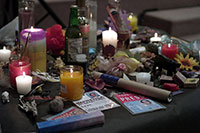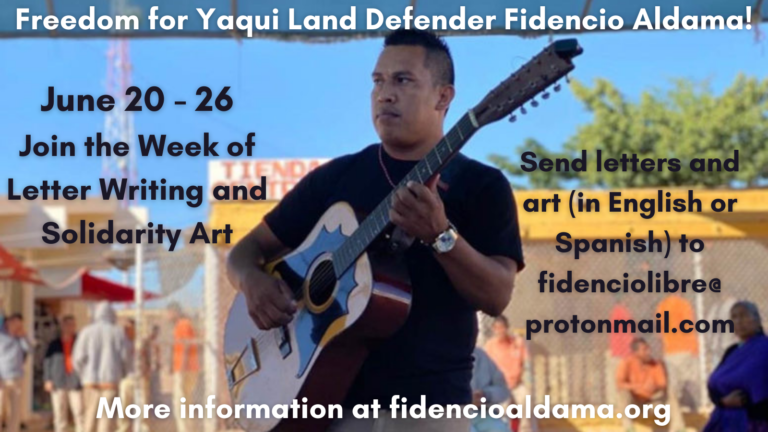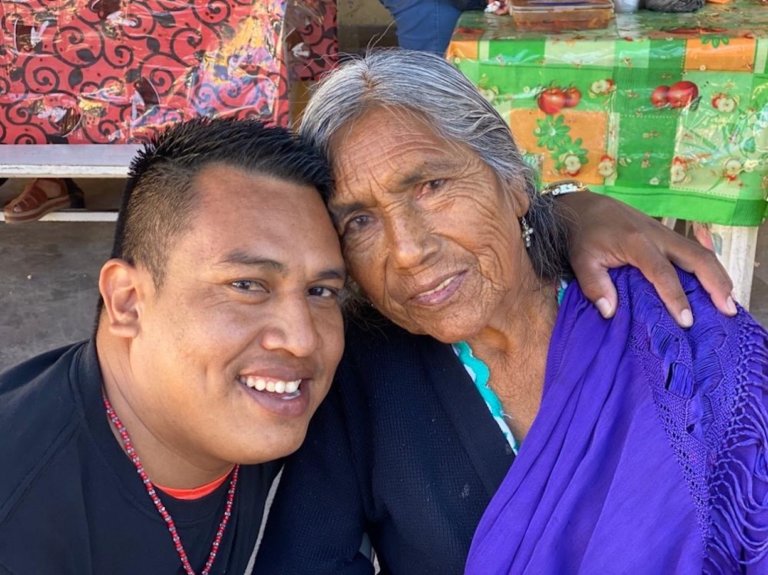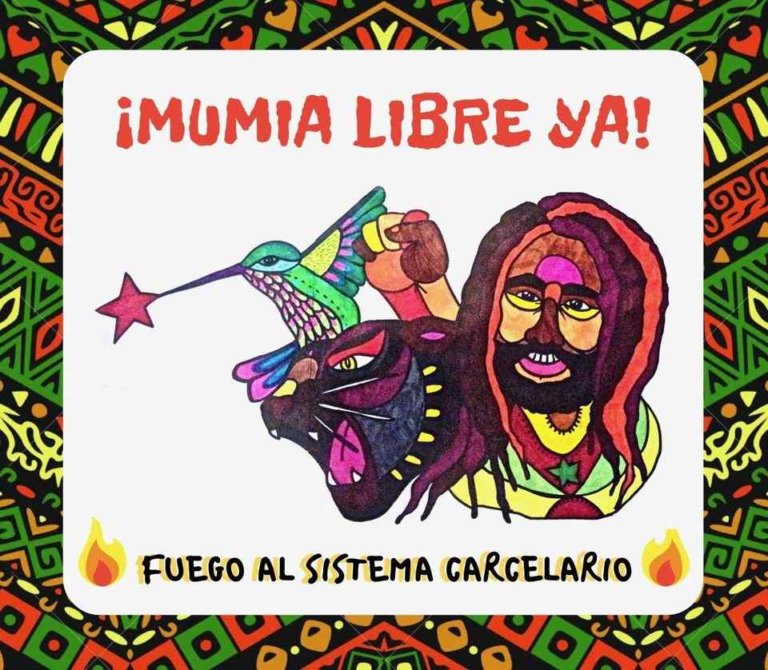From St. Mark’s Church to CHARAS, Brad’s community expresses its love.
November 12th, 2006 – John Tarleton writes: Two hundred friends of Brad Will sang, cried, shared stories, marched through the Lower East Side and stormed a padlocked community center Saturday as they remembered the longtime activist and independent journalist who was murdered on Oct. 27 by Mexican paramilitaries.
The day’s events began at a packed St. Mark’s Church where a three-hour plus memorial service was held featuring music, poetry, homemade video from Brad’s travels, readings from his writings and a slideshow of his life set to music by folksinger Stephanie Rogers. A giant banner of Brad holding a small child in his arms hung above the back of the alter. Below, a vivid, life-sized cardboard cutout of Brad holding a video camera was mounted atop his old bicycle. Brad’s sisters Wendy Mikavich and Christy were also present.
Photos and Background on NYC IMC
“We’re here acknowledging the life of a prophet and a saint,” said Frank Morales, an Associate Pastor at St. Mark’s and a veteran Lower East Side activist. “Over the years, I saw him go from a being a very heart-on-his-sleeve kind of guy to someone who was a very centered and wise-beyond-his-years person.”
The slideshow, which featured scores of family photos, left many in tears as it showed Brad’s life unfold from a playful little boy growing up in an affluent Chicago suburb to a playful, easygoing adult who refused to turn his eyes away from injustice and oppression anywhere in the world.
“You gave names and faces to the big body counts,” said his close friend Dyan Neary, who traveled with him in recent years throughout South America.
Brad, 36, was killed by paramilitaries who fired into a crowd while he was filming protests against the much-despised governor of the southern Mexican state of Oaxaca.
Throughout the ceremony, friends wove together the various strands of his adult life—from student of Allan Ginsberg at the Jack Kerouac School of Disembodied Poetics in Boulder, Colorado to his frontline activism in the old-growth forests of the Pacific Northwest and the squatter and community garden struggles on the Lower East Side to his work with Indymedia.
Tears turned to laughter when video footage was shown in which Brad (who could clean out anyone’s refrigerator) stood on the side of a highway trying to compose a haiku to hold aloft for passing motorists before finally giving up and trying to scrawl “84 East” on a piece of cardboard, which somehow came out as “84 Eat”.
The final reading of the ceremony was done by Andy Stern who narrated Brad’s last dispatch from Oaxaca on Oct. 16 where he describes spending the night with the friends and family of a local activist who was shot dead by local paramilitaries while standing guard at a barricade. “One more death—one more martyr in a dirty war,” Andy read aloud. “One more time to cry and hurt—one more time to know power and its ugly head—one more bullet cracks the night—one more night at the barricades—some keep the fires—others curl up and sleep—but all of them are with him as he rests one last night at his watch.”
Besides Andy and Dyan, at least 27 other present and past members of NYC Indymedia were on hand including Amy, Ana, Andrew, Bennett, Brandon, Chris, Dan, Erin, Erin, Firefly, Fritz, Jeanne, Ida, Jed, Jim, John, Josh, Kat, Kevin, Kevin, Lauren, Mike, Patty, Priya, Sam, Tahira and Tarikh. Members of Houston, Rochester and Danbury, CT. IMCs were also present.
The Hungry March Band lead the crowd out of the church and into the cobble-stoned front courtyard where people were able to nourish themselves from a heaping table full of dumpster score—pastries, muffins, hummus, loaves of dense whole wheat bread, two chocolate cakes, four cartons of premium not-from-concentrate orange juice and baskets of fruit overflowing with apples, oranges and bananas.
The Procession
A raucous funeral procession ensued as the crowd followed the Hungry March Band on a winding tour of the Lower East Side. Confused onlookers watched as the crowd roared by chanting “Brad Will, Presente”. A single cop car with flashing lights followed behind.
The procession passed the site of the former at 537-39 E. 5th St. that was demolished in Feb. 1997 despite Brad’s dramatic rooftop stand in the face of a city wrecking ball. The crowd also visited the former site of Esperanza Garden on 7th St. where Brad and others fought to stave off city bulldozers intent on clearing the land for real estate developers.
An older gardener who came of age in the 1960s recalled, “ In 1971, 1972, we thought a better world was just around the corner. We thought there would be successful revolutions in many countries around the world and in this country too. That didn’t prove to be the case. Now we know the struggle is a lifelong commitment.”
Departing from Esperanza, the procession made its way up Ave. C and turned left on East 9th St. When the crowd arrived at the former CHARAS Community Center on 635 E. 9th St., a cheer went up and then suddenly the padlocked front gate burst open and people poured into the front courtyard.
The giant five-story school building was abandoned by the city in the 1960s and reclaimed by Puerto Rican community activists in 1978. Over the next 20 years it would become a vibrant center for arts and activism in the Lower East Side before Mayor Rudy Giuliani had it auctioned off over heated protests to a real estate developer who is still embroiled in legal disputes with his neighbors.
Dozens of marchers entered the building, exploring the gutted first floor and tagging the walls with graffiti honoring Brad. Several people ventured up a dank, darkened stairwell by the light of their cell phones hoping to hang a banner from the front of the building. Startled pigeons flew low overhead crashing into windows. Unable to pry open any of the front windows, the protesters finally scampered back down the stairs and out into the fresh night air.
The procession finally ended at the Plaza Cultural Armando Perez at the corner of 9th and Ave. C where Brad’s friends planted flower bulbs in his memory in a spiral pattern on a small hillside near a willow tree. People then gathered in a circle and shared more Brad stories.
“The first time I met him, we were skinny-dipping in the Everglades and he was smoking a joint,” one person recalled. “And the last time I saw him, we were skinny-dipping in the Mississippi and he was smoking a joint.”
Another person recalled, “ I have a Prague story. Brad and I arrived super early for the convergence [against the Sept. 26-27, 2000 World Bank-IMF meetings] and he got the keys to an apartment that belonged to a friend of his who was going out of town and who didn’t know anything about the protests. Brad then managed to have a thousand gas masks shipped to that address and turned that place into a gas mask distribution depot. And then he filled the apartment from wall-to-wall with sleeping protesters. When the woman who’s apartment it was returned there was quite an argument. He had moved this whole underground world into one apartment. And he was able to convince her that this was the way it had to be, that this was the most important use for that apartment at that moment and that if she didn’t like it, she would have to go somewhere else.”
—
source, photos and background: http://nyc.indymedia.org/en/2006/11/79239.html




Brad Will: His second murder (English/Spanish)
Brad Will not be able to rest in peace
http://nyc.indymedia.org/or/2006/11/79436.html
Brad Will no podrá descansar en paz
http://nyc.indymedia.org/en/2006/11/79456.html
FOR THE LOVE OF BRAD (In 2 Parts) Video & One Poem
2 Videos and One Poem By Brad’s friend and colleague.
http://nyc.indymedia.org/en/2006/12/81359.html
Brad Will gets a loving, raucous, anarchist sendoff
http://www.thevillager.com/villager_185/bradwillgetsaloving.html
By Lincoln Anderson
A memorial service for Brad Will last Saturday filled St. Mark’s Church in the
Bowery with a crowd of about 250 people.
It was then followed by a jubilant and rowdy procession through the East Village ending with marchers breaking into the former CHARAS/El Bohio for about 20 minutes, inside which they cavorted, scrawled graffiti, twirled a fire bolas and rode a bike.
An activist-turned-journalist, Will, 36, was fatally shot by government-backed paramilitaries in Oaxaca City, Mexico, on Oct. 27. He was documenting the occupation of the city by insurgents fighting for the overthrow of the state’s governor, Ulises Ruiz, when he was killed.
Outside the historic church on Second Ave. and 10th St. was a lavish spread of freegan food — from dumpster-diving or donations — tomatoes, cheese, whole wheat bread, juices. Will was a freegan who tried to subsist on food that would otherwise go to waste.
Calling Will “a prophet and a saint,” Father Frank Morales, the church’s associate pastor, said Will encompassed “fearlessness and determination, but also searing intuition about people.”
“His spirit will continue to inspire us, and his spirit ain’t going anywhere,” he said.
On a table near the front of the church were piled Will’s possessions: T-shirts, pants, a bunch of quarters, toiletries, “Cars Suck” stickers, a styrofoam head he must have found somewhere.
“If there’s anything Brad was, he was a scatterer of seeds,” said his friend Andy Stern, encouraging people to come up afterwards and take something from the table.
A photo montage of Will’s life was projected on the wall. The youngest of four children from a Chicago suburb, there were photos of him as a Cub Scout, then as a clean-shaven young man. As photos of the smiling mature Will with a beard and ponytail, as most remembered him, were shown, audible sniffles began to fill the church. A woman exhaled a loud sigh.
Brandon Jourdan, a colleague of Will’s at Indymedia, said Will — an avowed anarchist — was in the tradition of other American anarchists who fought and sometimes died for their beliefs, such as Sacco and Vanzetti and the striking workers at the Haymarket Riots.
Videos were then projected: Will riding a freight train; breathing fire at a Critical Mass after-party in New York City in 2003; Will just grinning in a Bolivian rain forest at night amid the cacophony of the birds and animals.
Kevin Svorak, a former roommate, said Will, like him, had “shed his privilege” in order to become a committed activist.
“Brad did it all with a lot of grace,” Svorak said. “That’s why he was so well loved. He understood what it was all about. But I don’t think he intellectualized it too much. It was about finding the next party and the next action.”
More videos were shown, including one of the moment for which Will will probably be best remembered in the East Village, when he stood on the roof of the Fifth St. Squat in defiance of a wrecking ball that was knocking down the building. In the grainy, black-and-white video, Will throws his arms up in the air, in what looks like a cocky gesture, as if daring, “Bring it on!” Maybe, though, he was just trying to keep from getting killed by signaling to the demolition workers that he was there. The audience at the memorial applauded thunderously and pounded their feet on the floor at the sight of Will’s legendary face-off with the wrecking ball.
Another video showed Will in Esperanza Garden as his “black bear” lock was being sawed off by police. After he was arrested, Will speaking on camera, explains what he was fighting for: “New York can be so isolating — go home, watch TV and eat dinner. The Lower East Side is one of the last places where there was community.”
Harry Bubbins and other friends read passages from Will’s essay on the power of gardening from “We Are Everywhere.” From a section about the garden Will and others cultivated in a lot next to the Fifth St. Squat, Bubbins read, “Getting your hands into the soil is such a simple thing. You’re moving contrary to the concrete.”
In addition to being a gardener, Will was also a member of Earth First!, the radical environmental group. Priya, a.k.a. “Warcry,” recalled how when she first met Will he was tree-sitting in a harness 200 feet up in an old-growth Douglas fir in the Pacific Northwest to protect it from loggers. She noted that she’d just visited “Free” (Jeffrey Luers), an anarchist tree-sitter who is serving a 26-year sentence for torching three S.U.V.’s in Eugene, Ore., in 2000.
“Brad loved Free,” Warcry said.
Will’s two sisters, Wendy and Christy attended the memorial. Christy choked up as she read aloud Will’s last dispatch from Oaxaca, in which he described visiting a morgue to see the body of a man who had been killed the night before. The next day, Will’s body would be in that same morgue.
The Hungry March Band then led a raucous procession through the East Village past spots where Will had made a stand. As a black bicycle with wheels with spokes made of rebar in the shape of “A” for anarchy was carried amid the marchers, they walked east on 10th St., then down Avenue B. As they went, some wrote slogans on the asphalt with colored chalk: “Oaxaca Resist,” “Brad Will Presente” and what has become Will’s posthumous motto, “Stay in Trouble.”
Pausing for a moment by the Sixth and B Garden with its soaring trees and quirky tower structure, there was a moment of silence punctuated by the sounding of a conch horn. Next the procession wended its way to the site of the former Fifth St. Squat, now occupied by new housing.
Standing on a tree-pit guard, Michael Shenker, a fellow former squatter and roommate of Will’s, fired up the marchers by telling them, “The chant we used to say here was ‘Free the land!’”
Next they stopped on E. Seventh St. where Esperanza Garden once was. Today, it’s occupied by a building ironically named Eastville Gardens, where the Torres family, who live next door and had fought to save the garden, greeted them from their stoop.
“I always will remember Brad for the rest of my life,” said a Torres family member raising his fist in a power salute.
They then marched down Ninth St., stopping in front of the old P.S. 64, the former CHARAS/El Bohio arts center. The building has lain dormant for years as the community has struggled to keep it from being developed into a dorm and regain it as a community center. Someone had brought along a heavy-duty bolt cutter, and soon they had cut the chain on the door and about 50 people streamed through the construction fence and into the old building.
They graffitied on the walls — for Oaxaca, for Brad Will. A man on the old school’s front plaza twirled a bolas with fire on the ends. Someone zipped around through the hallways on a bike. Police in a squad car who had trailed the procession didn’t react. But after about 20 minutes, they all came out, next heading to La Plaza Cultural garden down the block. There around a burning barrel, stretched out in a large circle, people shared more memories of Will. Anne Bassen said she still has the black kitten Will gave her that he rescued from a squat being demolished; Fran Luck said Will was one of the few men who supported her feminist radio show. Andy Stern recalled how Will had rallied discouraged protesters at the International Monetary Fund meeting in Prague in 2000. Riding around on his bike, Will had gotten the Infernal Noise Brigade, a politically militant brass band, to start playing, which in turn sparked the “Blue Line” protesters back to life.
“Every corporate target in our path was totally destroyed,” Stern noted. He later said that while some anarchist protests involve property damage, they would never attack, for example, a mom-and-pop store. He said he and Will met in 1995 at Antioch College at a conference on anarchism. Asked if he felt Will had been targeted by the paramilitaries, Stern noted that Will had been actively pursuing them for the week up to his death. Asked if he thought Will had been perhaps too foolhardy, putting himself too near the gunfire, Stern said it was just bad luck.
“He didn’t want to die,” he said. “He loved his life.”
There were more memories shared about Will: about smoking joints while skinny-dipping in cold rivers, riding a freight train and then making love at the top of a grain silo in a thunderstorm. Many had come from all over the country to attend the memorial in the East Village.
Then someone started singing and playing guitar. Someone whipped out a flute and joined in. A guy with a drum came over and started beating out a rhythm. People started dancing around the fire barrel, dancing on into the night. From the raucous march through the East Village, to the heartfelt sharing of memories in the beautiful garden, to the breaking and entry into the former CHARAS, and the graffiti, all agreed, Brad Will would have definitely approved.
BRAD VIVE!
Paint For Brad (w/ the title of BRAD VIVE) in the Museum Of Art of The University of Ceará. The painting was exposed in a meeting of students of Social Science (www.erecs2007.cjb.net). The exposition had many themes, and the paint was one of many others kind of art work.
100cm X 150cm
I´m gonna make a better description of the work…
see portuguese info at:
http://brasil.indymedia.org/pt/blue/2007/05/380793.shtml